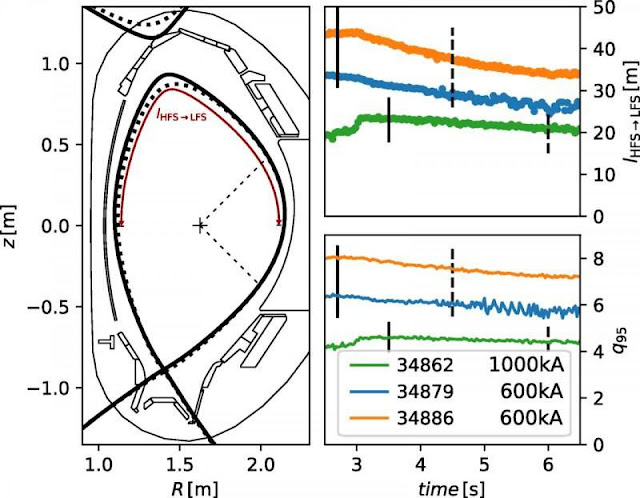The dynamics inside a fusion reactor are so complex sometimes the walls melt.
 |
Image credit: Max Planck Institute of Plasma physics. Cutaway of a Fusion Reactor |
A team of researchers from the Max Planck Institute for Plasma Physics (IPP) and the Vienna University of Technology (TU Wein) has found a way to control Type-I ELM plasma instabilities, which can melt the walls of fusion devices. The work is published in the journal Physical Review Letters.
Without a doubt someday it is possible to have fusion power
plants providing sustainable energy resolving our long-standing energy
problems. This is the main reason so many scientists throughout the world are
carrying out research on this power source. The generation of power from this
method actually mimics the sun.
 |
The reactions in a fusion generator |
For the method to work, plasmas must be heated to 100
million degrees Celsius in reactors. Magnetic fields enclose the plasma keeping
the walls of the reactor from melting. The shell that forms around the plasma
can only work because the outermost centimeters of the edge of that shell,
called the magnetically formed plasma edge, are extremely well insulated.
There is however a problem with this way of enclosing the
sun-level heat of the plasma. In that edge region, there are plasma
instabilities, called edge localized modes (ELMs). ELMs occur frequently,
during the fusion reaction. During an ELM, energetic particles from the plasma
may hit the wall of the reactor, potentially damaging it.
In a move that would remind anyone of offering an original
of something after many trials of different methods, only to find out the
original is the right one, the researchers went back to a mode of operation
that had been discarded previously.
Instead of large destructive instabilities potentially
damaging the walls of the reactor. There can be many small instabilities that
do not pose a risk of damaging the reactor’s walls.
"Our work represents a breakthrough in understanding
the occurrence and prevention of large Type I ELMs," says Elisabeth
Wolfrum, research group leader at IPP in Garching, Germany, and professor at TU
Wien. "The operation regime we propose is probably the most promising
scenario for future fusion power plant plasmas." The results have now been
published in the journal Physical Review Letters.
The reactor is called a toroidal tokamak fusion reactor. In
this reactor, ultra-hot plasma particles move at high speeds. Powerful magnetic
coils ensure that the particles remain confined instead of hitting the reactor
walls damaging it.
How a fusion reactor works is complicated, and the dynamics
inside are also complex. The motion of the particles depends on the plasma
density, temperature and magnetic field. How these parameters are chosen
dictates how the reactor will function. When the smaller particles of plasma
hit the walls or the reactor, instead of a round shape, the reactor takes on a
triangular shape with rounded corners, but the shape is far less damaged then
with a large ELM.
“It's a bit like a cooking pot with a lid, where the water
starts to boil," Georg Harrer lead author of the paper explains. "If
the pressure keeps building up, the lid will lift and rattle heavily due to the
escaping steam. But if you tilt the lid slightly, then steam can continuously
escape, and the lid remains stable and doesn't rattle."
This is a big step to having a continuous fusion reaction
with huge energy potential. A perpetual energy source.




0 Comments